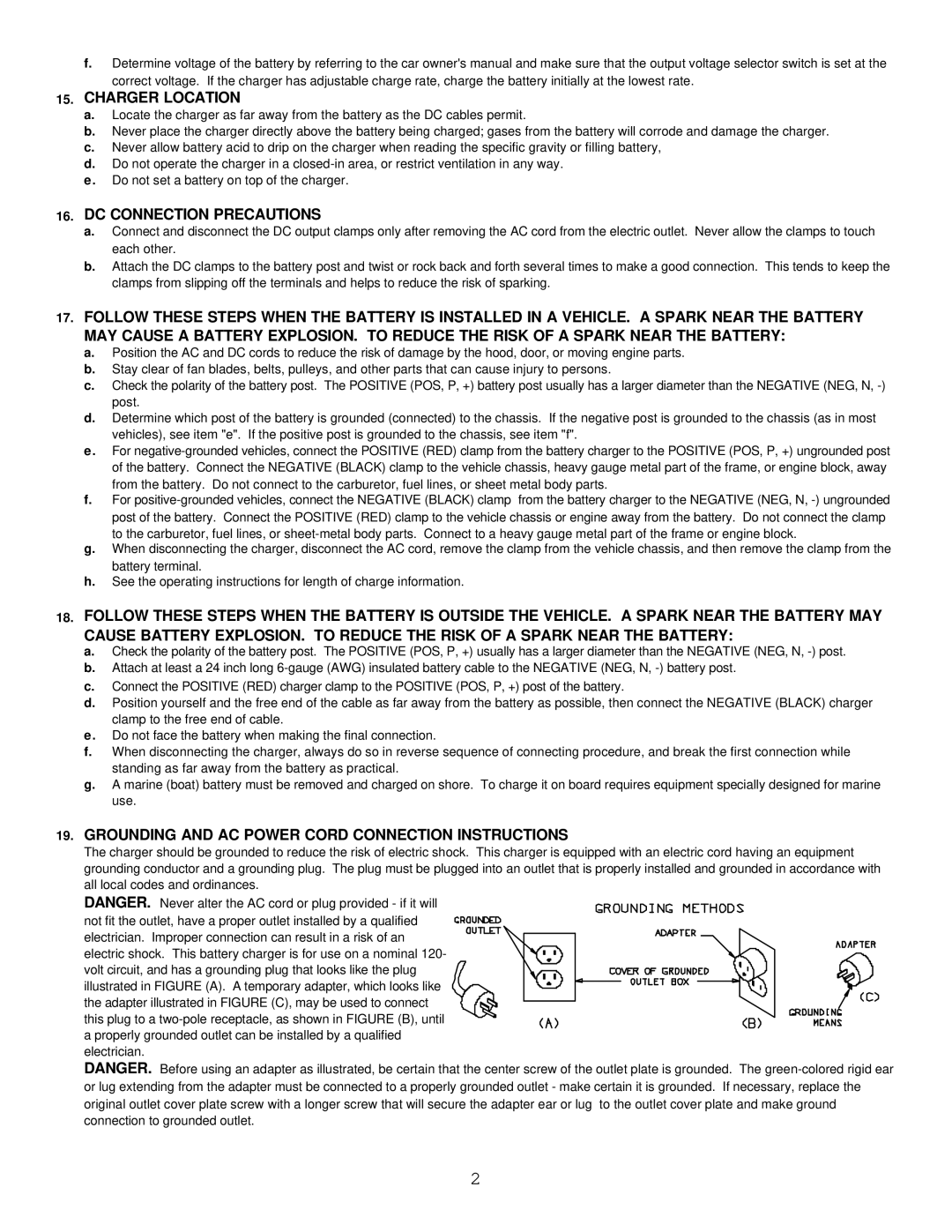
f.Determine voltage of the battery by referring to the car owner's manual and make sure that the output voltage selector switch is set at the correct voltage. If the charger has adjustable charge rate, charge the battery initially at the lowest rate.
15.CHARGER LOCATION
a.Locate the charger as far away from the battery as the DC cables permit.
b.Never place the charger directly above the battery being charged; gases from the battery will corrode and damage the charger.
c.Never allow battery acid to drip on the charger when reading the specific gravity or filling battery,
d.Do not operate the charger in a
e. Do not set a battery on top of the charger.
16.DC CONNECTION PRECAUTIONS
a.Connect and disconnect the DC output clamps only after removing the AC cord from the electric outlet. Never allow the clamps to touch each other.
b.Attach the DC clamps to the battery post and twist or rock back and forth several times to make a good connection. This tends to keep the clamps from slipping off the terminals and helps to reduce the risk of sparking.
17.FOLLOW THESE STEPS WHEN THE BATTERY IS INSTALLED IN A VEHICLE. A SPARK NEAR THE BATTERY MAY CAUSE A BATTERY EXPLOSION. TO REDUCE THE RISK OF A SPARK NEAR THE BATTERY:
a.Position the AC and DC cords to reduce the risk of damage by the hood, door, or moving engine parts.
b.Stay clear of fan blades, belts, pulleys, and other parts that can cause injury to persons.
c.Check the polarity of the battery post. The POSITIVE (POS, P, +) battery post usually has a larger diameter than the NEGATIVE (NEG, N,
d.Determine which post of the battery is grounded (connected) to the chassis. If the negative post is grounded to the chassis (as in most vehicles), see item "e". If the positive post is grounded to the chassis, see item "f".
e. For
f.For
g.When disconnecting the charger, disconnect the AC cord, remove the clamp from the vehicle chassis, and then remove the clamp from the battery terminal.
h.See the operating instructions for length of charge information.
18.FOLLOW THESE STEPS WHEN THE BATTERY IS OUTSIDE THE VEHICLE. A SPARK NEAR THE BATTERY MAY CAUSE BATTERY EXPLOSION. TO REDUCE THE RISK OF A SPARK NEAR THE BATTERY:
a.Check the polarity of the battery post. The POSITIVE (POS, P, +) usually has a larger diameter than the NEGATIVE (NEG, N,
b.Attach at least a 24 inch long
c.Connect the POSITIVE (RED) charger clamp to the POSITIVE (POS, P, +) post of the battery.
d.Position yourself and the free end of the cable as far away from the battery as possible, then connect the NEGATIVE (BLACK) charger clamp to the free end of cable.
e. Do not face the battery when making the final connection.
f.When disconnecting the charger, always do so in reverse sequence of connecting procedure, and break the first connection while standing as far away from the battery as practical.
g.A marine (boat) battery must be removed and charged on shore. To charge it on board requires equipment specially designed for marine use.
19.GROUNDING AND AC POWER CORD CONNECTION INSTRUCTIONS
The charger should be grounded to reduce the risk of electric shock. This charger is equipped with an electric cord having an equipment grounding conductor and a grounding plug. The plug must be plugged into an outlet that is properly installed and grounded in accordance with all local codes and ordinances.
DANGER. Never alter the AC cord or plug provided - if it will not fit the outlet, have a proper outlet installed by a qualified
electrician. Improper connection can result in a risk of an
electric shock. This battery charger is for use on a nominal 120- volt circuit, and has a grounding plug that looks like the plug illustrated in FIGURE (A). A temporary adapter, which looks like the adapter illustrated in FIGURE (C), may be used to connect this plug to a
a properly grounded outlet can be installed by a qualified electrician.
DANGER. Before using an adapter as illustrated, be certain that the center screw of the outlet plate is grounded. The
2
